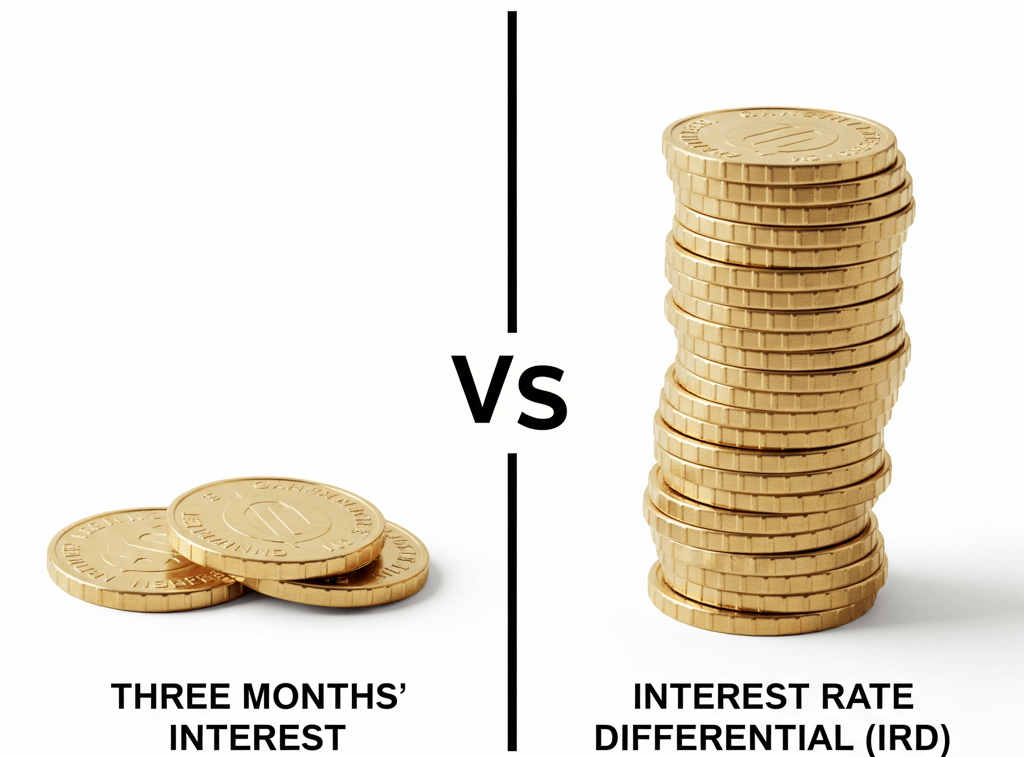Breaking Your Mortgage: The Ultimate Guide to Mortgage Penalties in Ontario
Facing a life change that requires you to break your mortgage? The thought of a massive, confusing penalty can be paralyzing. This ultimate guide breaks down the two types of mortgage penalties in Ontario—Three Months' Interest and the often misunderstood Interest Rate Differential (IRD). Learn how these penalties are calculated with simple examples and discover actionable strategies that could potentially save you thousands.
Lokesh Tuli


Life happens. A dream job opportunity comes up in another city. Your family grows, and you need more space. Or sometimes, financial circumstances change. Whatever the reason, you’re considering selling your home or refinancing, but one terrifying question stands in your way: “What is the penalty for breaking my mortgage?”
It’s a topic filled with confusing jargon, hidden calculations, and horror stories of five-figure penalties. This fear of the unknown stops many homeowners in their tracks.
As a Mortgage Planner who specializes in finding creative solutions for tricky files, my goal is to demystify this process for you. This guide will explain in simple terms why penalties exist, how they are calculated, and what strategic options you have.
Why Do Mortgage Penalties Even Exist?
First, it’s important to understand that a penalty isn't a punishment. When a lender gives you a mortgage, they are making a business investment. They expect to earn a certain amount of interest from you over the agreed-upon term (e.g., 5 years). If you break that agreement early, they lose out on their expected profit. The penalty is how the lender recoups some of those anticipated earnings.
The Two Types of Penalties: A Clear Breakdown
In Canada, your penalty will almost always be the greater of two possible calculations:
1. Three Months' Interest
This is the simpler and usually much cheaper penalty. It is most often applied to variable-rate mortgages.
How it’s calculated: The formula is straightforward. It’s simply three months' worth of interest payments on your current mortgage balance at your current interest rate.
Example:
Your outstanding mortgage balance: $400,000
Your interest rate: 5.5%
The calculation: ($400,000 x 0.055) / 12 months x 3 = $5,500 Penalty
2. The Interest Rate Differential (IRD)
This is the big one. The IRD is the penalty that can lead to shocking five-figure amounts and is most often applied to fixed-rate mortgages.
What it is, in simple terms: The IRD is designed to compensate the lender for the difference between your locked-in interest rate and the interest rate they can charge someone today for a new mortgage with a similar remaining term.
How it’s calculated (simplified example): While each lender’s formula varies slightly, the basic concept is:
Find the rate difference: The lender subtracts their current rate for your remaining term from your original rate.
Your fixed rate: 6.0%
Lender's current rate for a similar term: 4.5%
Rate Difference: 1.5% (or 0.015)
Calculate the annual difference: Multiply this difference by your mortgage balance.
$400,000 x 0.015 = $6,000 per year
Multiply by time remaining: Multiply that annual number by the number of years left in your term.
$6,000 x 3 years remaining = $18,000 Estimated IRD Penalty
As you can see, the IRD penalty can be significantly higher than a simple three months' interest penalty.
Frequently Asked Questions (FAQ)
1. Is it difficult to switch lenders at renewal? Not at all. When you work with a mortgage professional, the process is simple and streamlined. We handle the paperwork and communication to make the switch seamless.
2. Will shopping for a new mortgage hurt my credit score? When done correctly, no. A single credit inquiry from a mortgage professional allows us to check with multiple lenders. This is treated as a single "hard inquiry" and has a minimal, temporary impact on your score, unlike applying to multiple lenders yourself over several weeks.
3. What’s the difference between renewing and refinancing? A renewal is simply renewing your existing mortgage balance with a new term and rate (either with your current lender or a new one). A refinance involves changing the terms of your mortgage, often by borrowing more than you currently owe to access equity or consolidate debt. We can discuss which is right for you.
Can You Avoid or Reduce Your Mortgage Penalty?
You are not without options. A good strategy can potentially save you thousands.
Strategy 1: Porting Your Mortgage: If you are buying a new home, many lenders will allow you to "port" or transfer your existing mortgage (and its current rate) to the new property. This is an excellent way to avoid a penalty entirely.
Strategy 2: An Assumable Mortgage: In some cases, the person buying your home may be able to "assume" or take over your mortgage. This is less common but can be a powerful negotiating tool, especially if you have a great interest rate.
Strategy 3: Using Prepayment Privileges: Most mortgages allow you to make a lump-sum prepayment each year (e.g., 15% of the original principal). By making a large prepayment before you break the mortgage, you reduce the principal balance that the penalty is calculated on.




How a Mortgage Strategist Can Help You Save Money
Facing a mortgage penalty is a classic "tricky file." It requires more than just a calculation; it requires a strategy. My role is to:
Analyze the True Cost: I will help you get the exact penalty amount from your lender.
Conduct a Cost-Benefit Analysis: We will calculate if breaking your mortgage to take advantage of today’s lower rates will actually save you money in the long run, even after paying the penalty.
Create a Smart Plan: We will explore all your options—porting, refinancing, and more—to create a smart planthat aligns with your financial goals.
Facing a life change and worried about your mortgage penalty? Don't navigate this alone. A confidential consultation can clarify your options and provide a clear path forward.
Schedule a complimentary strategy session below to see if breaking your mortgage is the right financial move for you.
Use my calendar below to book a time that works for you.